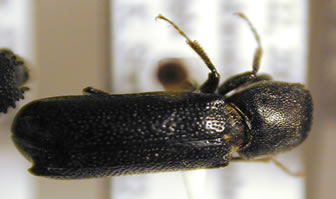| This beetle is a dark reddish-brown color and has a body length of approximately 3 mm. The antennae are its characteristic features as they have three distinct segments. The lesser grain borer is one of the most destructive beetles known to attack grain stores. It consumes the germ and endosperm of grain kernels, reducing them to a shell with a distinctive hole. The grain borer's diet is not restricted to grain products but also includes cereals, seeds, dried fruit, drugs, cork, wood, and paper products. Optimal breeding conditions are between 20 and 34 C with 14% relative humidity. The grain borer may have a lifespan of up to 240 days. |
|
 |
|
|
|
| How do grain borer spread? |
|
| This pantry pest is very common in warmer regions; however, in many places in Canada it is restricted to buildings. This limitation reduces its abundance in Canada. The grain borer is spread in he same manner as other pantry pests. The lesser grain borer attacks a wide variety of products that could make it into your home. These products include grains, cereals, seeds, dried fruit, drugs, cork, wood, and paper products. |
|
| How can I identify grain borer? |
|
| Physically, the lesser grain borer is best characterized by its antennae. These antennae have three distinct segments. The beetle is colored a dark reddish-brown and has a body typically 3 mm in length. This beetle will burrow through the kernel and feed on the germ and endosperm. You may have a grain borer infestation if irregularly shaped holes, tunnels, excess flour, or a sweet odor are discovered. If you are having trouble identifying the beetle species, contact us for professional pest control service. |
|
| How do I control grain borer? |
|
| Controlling a grain borer outbreak in your home can be very difficult. These beetles are not easy to irradicate once they have settled. The first step is to remove all possible food sources. Seal anything from your pantry they might feed on in air tight plastic bags. Check these bags in a week and if any grain borer appear, throw out the item immediately. Grain borer like to eat grass seed and rodenticide (rat poison) so be sure to remove or monitor these items if they are present. Subsequently, all areas that had a grain borer presence should be thoroughly vacuumed, including small cracks, baseboards, and cupboard shelves. Next, the infested areas should be treated with Baygon aerosol. Finally, if the infestation area was large, use of Permethrin may be required. For professional grain borer control call Nimby Pest Management. |
|
| 1-888-681-6266 |

